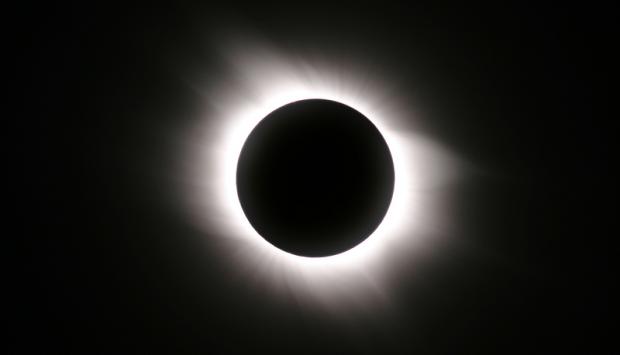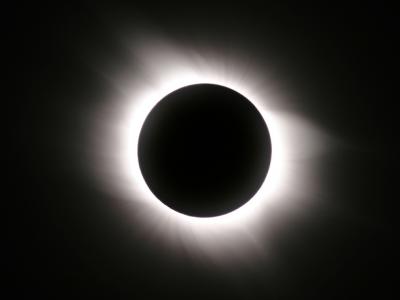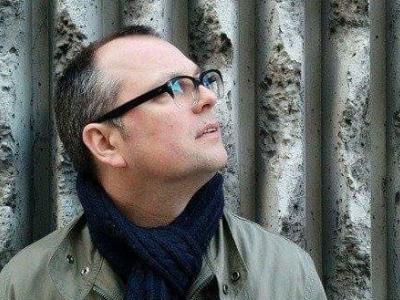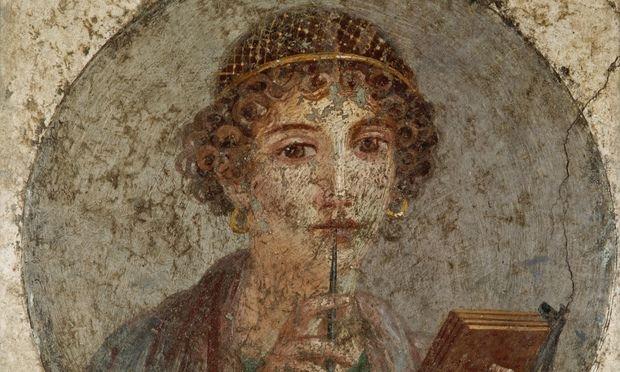Something as simple as a star

Little Atoms began hosting a series of events called Two Cultures in September. Each event brings together a poet and scientists to discuss a particular aspect of science. This was the first talk in the series, focusing on the role of the sun in our lives and imaginations
Lucie Green: My name's Lucie Green and I'm representing the science side of the “two cultures”. My background is in astrophysics and I work at a London university in a space science laboratory, which is the most thrilling title , for me to be able to say that I'm a space scientist. And my focus for the last 20 years has been trying to understand the sun.
And what I want to do this evening is take us on a bit of journey that I've been on, where the sun has gone for me from being this very dull, uneventful object to actually something that is a lot more interesting and a lot more dynamic.
Simon Barraclough: Thank you Lucie. My background is in being a poet and being fascinated by astronomy since I was a very little boy. And I have worked with Lucie in the past. I was writer in residence at the space science laboratory where Lucie works and got scientists from all different kinds of backgrounds, not just astrophysics, also physics, to write some poetry.
I’ve spent the last three or four years obsessed with the sun. I don't quite know how it happened, but this weird switch went in my head and I became obsessed started writing poems obsessively and produced a book all about the sun called Sunspots. We also turned it into a one man show with songs and performances and you'll be seeing strange little snippets from this show.
We're going to alternate our little presentations as we go through, and we're going to start with one of the songs I produced for the show called "About the journey of photons from the centre of the sun to your eyeballs", so let's go for that shall we.
Sunspots Photon from Jack Wake-Walker on Vimeo.
For I will consider my Star Sol.
For I am the servant of this Living God and daily serve her.
For at the first glance of the glory of God in the East I worship in
my way.
For this is done by fixing espresso and watching the pinkening light
on The Shard.
For then she waves her warmth across the scene and lifts the hearts
of those who took a Night Bus at 4 a.m. to clean HQs.
For she tickles the orbitals of foxes in their stride and hies them
home.
For having risen and settled into her groove she begins to consider
herself.
For this she performs in eleven degrees.
For first she does the Planck to strengthen core stability.
For secondly she runs a malware scan for comets closing in.
For thirdly she completes the paperwork for eclipses total, annular
and partial.
For fourthly: flares.
For fifthly she sorts her sunspots into pairs.
For sixthly she gives neutrinos Priority Boarding.
For seventhly she referees the arm-wrestling match between the
upstart fusion and gravity.
For eighthly she weaves flux ropes and thinks up skipping games.
For ninthly she degausses her plasma screens.
For tenthly she is profligate with her photons.
For eleventhly: star jumps.
For having considered herself she will consider her neighbours.
For she runs a cloth around the ecliptic to make it gleam.
For she oils the wheels of any planets gliding there.
For she sends invites out to wallflowers in the Oort cloud.
For she issues shadows for children to dodge as they make their
way to school.
For she shakes out her blankets for devotees of helioseismology.
For when she takes her prey she plays with it to give it a chance.
For one planet in nine escapes by her dallying.
For in her morning orisons she loves the Earth and the Earth loves
her.
For she is of the tribe of Tyger! Tyger!
For she hands out colouring books to chameleons in the morning.
For when it is time to rise she blushes to be seen at so intimate an
hour.
For when it is time to set she is crimson ashamed to run out on us.
For though she neither rises nor sets she thinks it best that we believe
so, so that we can take our rest and fuel our waking with
anticipation.
For she lifts oceans over mountains without thinking.
For she tries to solve the puzzle of the weather, placing this here
and that there and attempts to even out the air.
For she is a mixture of gravity and waggery.
For she’s a stickler for solstices.
For she booms like a woofer for those that can hear.
For she cares not what lives as long as all live.
For she takes her time.
For she lenses the light from distant stars to swerve it into our
sockets.
For sometimes in the winter haze she’s as pale as a lemon drop and
lets us watch her bathe unpunished.
For she never calls in sick.
For her colours are open-source.
For every raindrop’s an excuse for Mardi Gras,
For she will work on her drafts for a million years and release them
typo-free.
For she will lash out and then regret the hurt.
For she promises radio hams jam tomorrow.
For your power grid is a cobweb she walks into when she steps off
her porch.
For she kept mum through the Maunder Minimum.
For her behaviour is definitely ‘on the spectrum’.
For she keeps dark about dark matter but she definitely knows
something.
For she plays Miss Prism in The Importance of Being Furnaced.
For she offers board and lodging to Turner’s ‘Angel in the Sun’.
For she made a great figure in Egypt for her signal services.
For she can fuse the wounded parts of a broken heart and release
the lost mass as hope.
For she spins plates to create auroras.
For she leaves clues all over the place: some cryptic, some quick,
some general knowledge-based.
For she is hands-off.
For she tends to micro-manage.
For she lays down squares of light for your pets to sleep in.
For she turns a blind eye to all the creeping, swooping killers of the
night but leaves a Moon-faced night-light on.
For her sunquakes flatten no buildings, gridlock no cities, disgorge
no refugees.
For she is not too proud to dry your smalls.
For she gives us heliopause and time to rethink disastrous
decisions.
For Ray-Bans.
For she polarises opinion.
For her secrets are waiting to free us.
For she appreciates Stonehenge and visits every day.
For she sets herself by the grid of Manhattan.
For she will kill you with the loving of you.
For she can shine
Lucie: I always love hearing Simon reading his poetry, it's so nice and it's so invigorating to hear his perspective on our sun and find someone who has so much passion for an object I have so much passion for.
It's interesting to view ourselves as the latest in a long line of people who've been absolutely mesmerised by the sun and wondered what it is and who it is.
Because the sun has inspired civilisations for thousands of years – even longer. It's interesting to think about how early ideas involved, to think about what the sun actually is. How do we explain it? And so when we look back at early civilisations we find that every single one has their god associated with fire and light. If you were to think about words describe the sun you might think about flame, fire, heat.
I know when I go into schools and I ask children to tell me the words that they, that come to their minds if I show them pictures like this of the sun, that's exactly what they say. Incidentally this is one of my favourite pictures, this was taken from the top of Mauna Kea [sp?] on a visit that I was very lucky to make last year. So this is the sun setting. And we drove up to this mountain, 14,000 feet above sea level, got there to watch this spectacle, a daily spectacle for the astronomers up here. And I thought we would be there by ourselves having this peaceful moment, but you might be able to see the crowds that are gathered on the top of this mountain with this very thin atmosphere and people were suffering from altitude sickness, but we made that journey because we wanted to see the sun from this very special and stunning place.
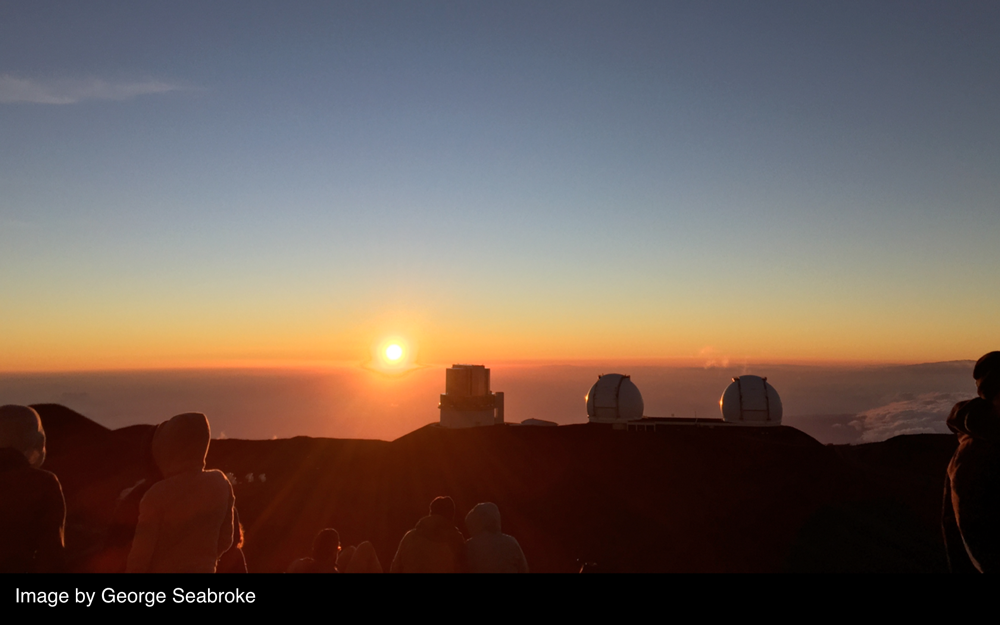
So people have always ascribed power to the sun and they've tried to understand it.And as a scientist, it's our role to test those ideas. But how is the sun functioning? How does it shine? I find it very interesting that when we try and grapple with this very big question, we draw initially on things we are very familiar with. But the challenge as a scientist is to not be constrained by that. And try and be open minded to the things that we don't yet know.
In the first movie of Simon's that we saw, the photon movie, I love that one. I love the line "photon, get a move on". So maybe you can just say what you were thinking when you were writing that?
Simon: I didn't learn until a few years ago, when I started reading about the sun a bit more, that these photons that leave the surface of the sun and travel obviously and inevitably and unavoidably at the speed of light, that's kind of what they're born to do. They get created in the sun's core, but because the sun's so massive, they spend hundreds of thousands of years colliding with other particles, exchanging levels of energy and so that the light that gets to the surface of the sun and hits us within eight minutes may have taken, and I'm right, anything from 100,000 years and a million years just to get out of this packed, dense ball of matter, and I just thought that was kind of mindblowing, because we think of light as being so instantaneous and so fresh. And unimaginably fast. But then when you put light into the context of the universe, which is 13.9 billion years old and how vast it is, of course light is grindingly slow. There are things we can't even see because the light hasn't reached us yet. That contrast is the kind of thing that gets poets and writers kind of excited. It's also a love poem as well. I was impatient with someone at the time, and I thought, I'm going to bury all this stuff in solar science.
Lucie: That interpretation was hidden on me, all I saw was the sun! And love for photons.
So when we think about what the sun actually is, it is a spherical ball of glowing gas, at its heart it is a very simple object. And that brings us to the title of this talk, Something So Simple as a Star.
And the person who spoke those words, or wrote those words, was Arthur Eddington. He was one of Britain's most successful mathematicians and astrophysicists. So he lived between 1882 and 1944, and he was working on trying to understand what makes stars shine.
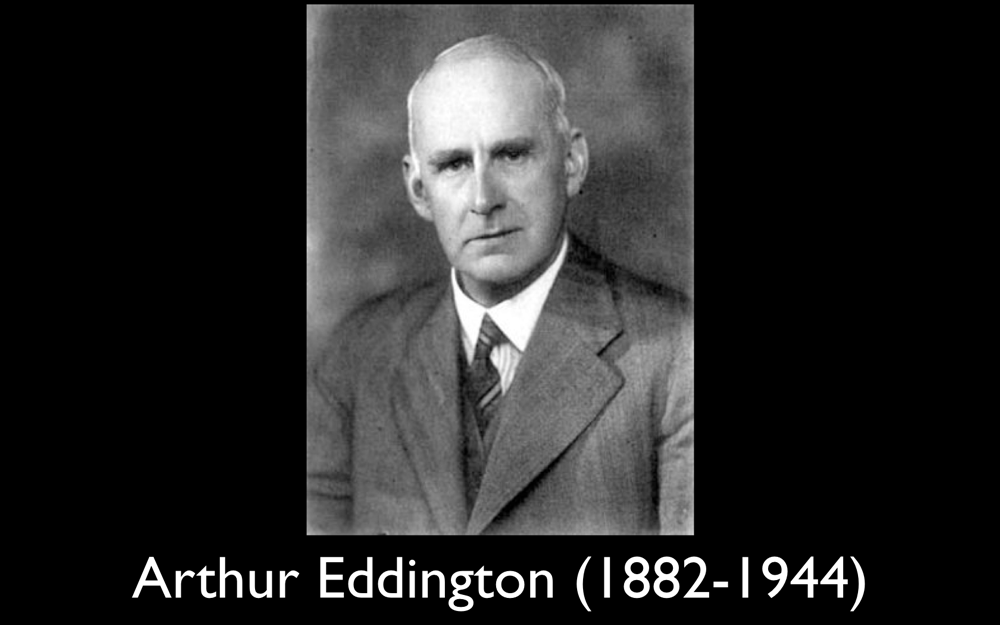
So they knew at the time that the sun is just a spherical ball of gas – and he was trying to work out what was going on inside.
In 1926, he wrote one of the most influential books we've ever had in astrophysics, called The Internal Constitution of Stars. His book was hugely influential, and he ends it by saying that he hopes that we're not too far off from understanding something so simple as a star.
And I just think those words are lovely, because at face value the sun does seem like a simple object, but one of the things that fascinates me as a scientist is how long it's taken us to even come to that conclusion and how twisted and full of turns that journey has been.
So to understand the sun we had to have almost 300 years of scientific studies from the early telescopes in the 1600s, learning about electricity, magnetism, light, atomic physics, gravity, forces – all of these things come together in our scientific studies of the sun, and it's been a long journey. So how far have we come in understanding something so simple as a star?
Around the time Arthur Eddington lived, we knew some basics about how the energy was being created; we knew the size of the sun, we knew the composition of the sun, that it's mostly made of hydrogen. That was a discovery made by a British female scientist, Cecilia Payne-Gaposhkin. No-one ever talks about her but she discovered what the entire universe is made of – hydrogen.
So we had the foundations in space. But it's sad to me that Arthur Eddington didn't get to see the space era.
When we developed the ability to go into space, we got above the earth's atmosphere, and we saw the sun truly for the first time, fully without the obscuration of the earth's atmosphere blocking some of the light, and causing it to scintillate. I've got three pictures here that for me mark the journey we've been on in space science. Any rocket buffs out there might recognise the picture on the left hand side, that is a V2 rocket that was left over after the Second World War. When the war was ending, the rockets and the German rocket scientists surrendered to America, and they started using the rockets on the face of it to do research looking at the sun and the earth's upper atmosphere. But also they were learning about the German rocket technology at the same time.
So the first rocket went up and studied the sun. There was a technology called a rockon, so a hybrid of a rocket and a balloon. They decided that they wanted to be able to launch rockets at a moment's notice to study the sun when it got active. And they couldn't just leave rockets on the launchpad, because that tied up the launchpad for perhaps days or weeks at a time, so they decided to launch the rocket on a balloon, and it would just drift, and then whenever the sun produces a burst of activity, they’d fire the rocket up through the balloon, solving the problem of what to do with the balloon at the same time, and then the rockets would carry up the instruments to make the study of the sun. Which was ingenious. We don't do this anymore, but I'm a big fan of rockons. And then on the right hand side we've got a picture of the first orbiting space station, which is called Skylab.
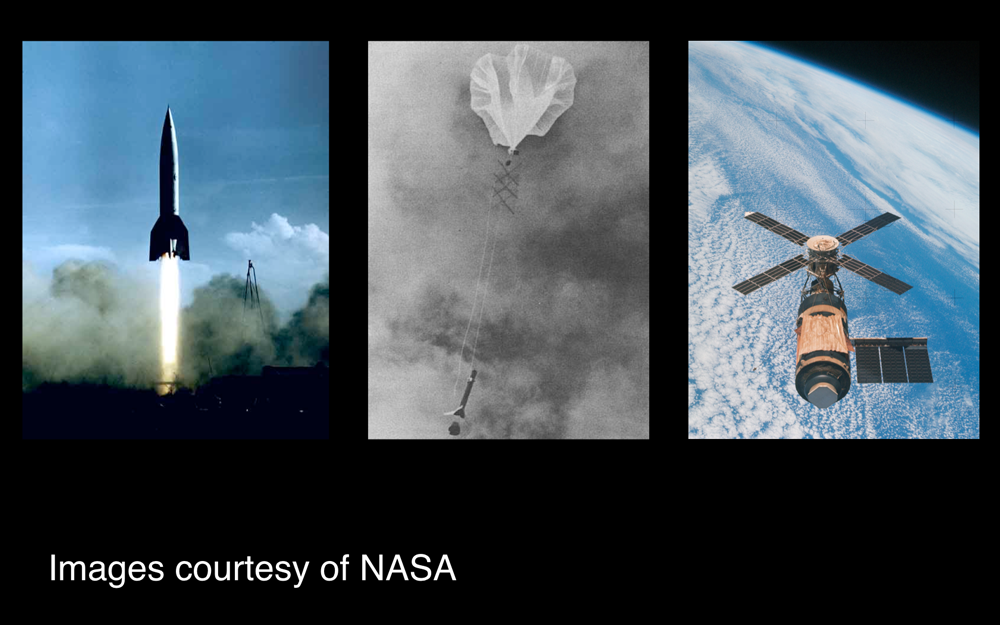
This is a space station that was dedicated to understanding how humans would function in space, but also it had on board a sophisticated solar observatory. Astronauts were trained as solar physicists before they went to this space station, so they could operate the telescopes for people like myself. And this was orbiting in the 1970s. So after the Apollo era ended, NASA had its sights set on the sun, and it used the third stage of a Saturn V rocket and turned it into this orbiting space station, which I just think is wonderful, and in fact it deorbited and came down over Western Australia.
If you're ever in Western Australia drive to a town called Esperance, where you can go and see this space station now in this tiny, tiny museum. It's absolutely phenomenal, I made a pilgrimage there a few years ago. I flew for a day to Perth then I drove three days to Esperance, and I found the space station.
Simon: I remember I was a little boy living in Huddersfield, and I was hoping and praying that Skylab would land on Huddersfield.
It seemed such a waste to land in the middle of Australia, I thought. Unpopulated area.
Lucie: Well it's an interesting point. So in the museum, you go in and it's this corrugated iron museum. Lots of buildings in Australia have corrugated iron. And there are other displays. And then you've got Sky Lab. And it's not given any more prominence than any other exhibit in there, but it's such a significant mission.
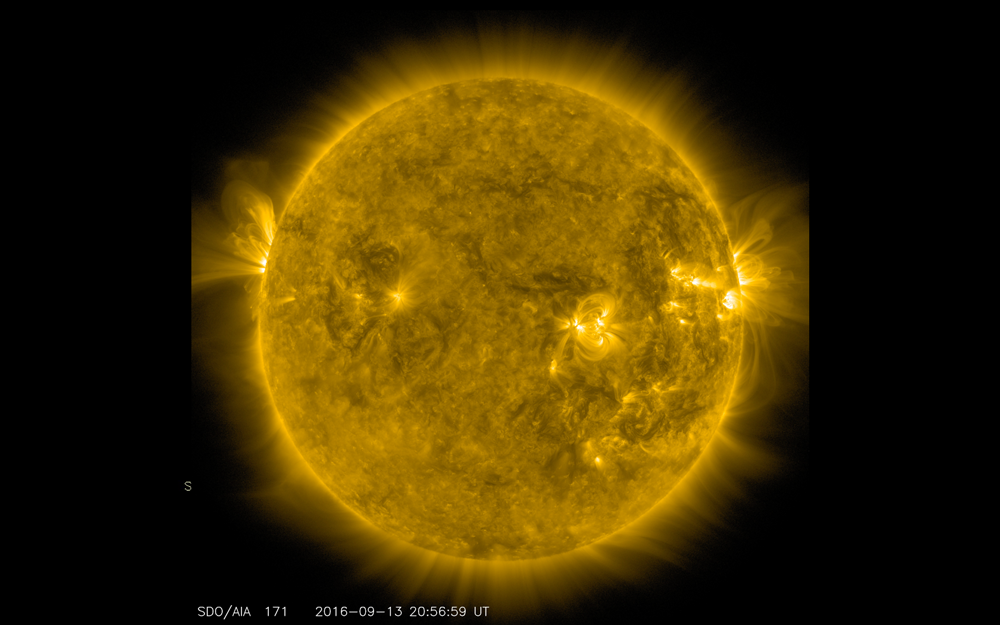
Now we have the space age, looking at the sun, we can view it in all wavelengths of light that we want to. So the image I showed before is just the visible light, how our eyes detect the sun, but the beauty of going into space is we can see the sun in ultraviolet light, and x-rays, and I wanted to show you before I hand back to Simon, how the sun looked yesterday, taken using wavelengths of light that our eyes can't detect. So these images come from a mission called the Solar Dynamics Observator. Everyone can get these images, they're all freely available because it's a publicly funded mission so therefore the public can get hold of this data. And they show the sun at the same time, just taken at different wavelengths of light, going from longer wavelengths on the left to shorter wavelengths on the right.
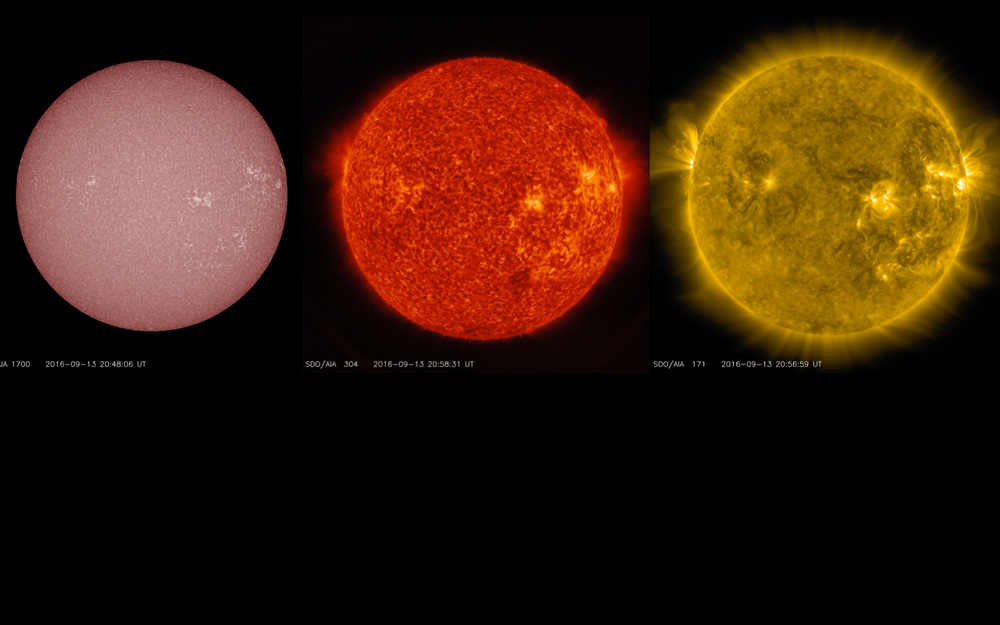
And what I hope is apparent is the sun looks different when you look at it in different wavelengths of light. So you see the surface where the sun looks like a very smooth ball, and then you come up actually into the atmosphere and you see all this structure, and this is actually all created by magnetic fields. Everything you're seeing there, the shapes and the gas, are all created by magnetic fields. So magnetism is one of the key things that we need to understand to know why the sun looks like it does. So these are images from yesterday.
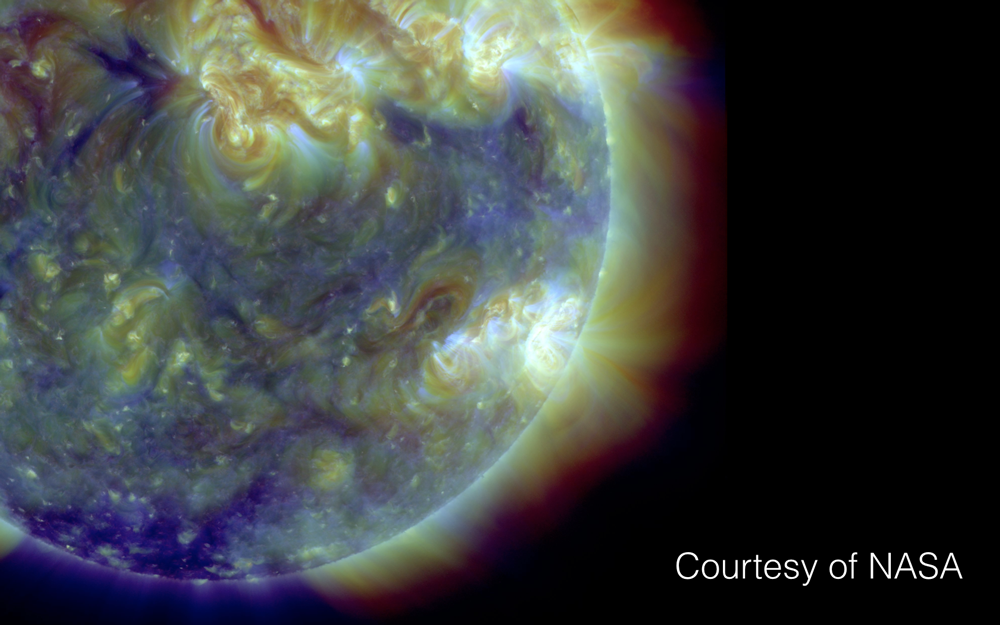
And you can get even more up to date images if you have a look when you get home and see them.
Simon:
They used to live in awe of me:
the godhead, the fulcrum of perfection,
the prime mover, the alma mater,
the chief creator who could ripen grapes
as an afterthought, bringing culture
and savour, and civilisation.
Now I’m just the buoy, the marker
that indicates the exit from the harbour,
something to be got past,
something of a feather in one’s cap,
something to be got under one’s belt,
to be pocketed, regarded perhaps
as a useful pointer, a fond memento.
________________________
The universe hurts.
But you knew that.
I pity you your brief lives:
over in the squint of an eye.
It’s a problem
but don’t overblink it.
Some stars are shy:
the distant ones,
the clingy, binary ones,
the dense ones who try to swallow
their own tails of light
but lack the mass,
didn’t get the right start in life.
Step forward,
feel the warmth.
I’ll let you in on a secret.
Hell is just an oven pre-heating
for something really wicked
coming this way.
Turn around for your shadow. |
What do you see?
Four legs, two legs, three?
How limpingly Oedipal you can be.
Ever want to be a star?
It’s a simple recipe —
most households have the ingredients.
Everyone has a shelfful of dead cells,
an old bag of gravity
trapped at the back of the pantry.
You just don’t have enough
of what it takes.
Is Jupiter a failed star
or an over-achieving planet?
You decide.
Put your spin on it.
Stars are the Yes Men of the universe.
No negative capability.
Four billion years of saying “Yes”
and five billion years of “Yeses” yet to come.
I’d love to use up this core,
begin to mumble ”Maybe” for a trillion years or more.
I pity you your brief lives.
Are you planning for your nebula?
The things you’ll leave behind.
Your inventory,
memento mori.
The universe hurts.
But you knew that.
(I’m starting to repeat myself,
my daddy was a pulsar.)
Poor steadfast Keats knew it.
I spent a million years
making one perfect photon
to send to the Spanish Steps
the dawn they carried him down.
A star will never let you down
but a planet will break your heart.
I envy you your short lives.
Lucie: So. At this point, I'd like to put the sun in context against some other stars. It is just a star, a simple star. How special is it?
We heard about the planets – Jupiter is potentially a failed star. This schematic shows the size of the sun on the right hand side. Jupiter you can just about make out is the largest planet on the left. And then all the other planets, we can barely see them they're so small. You could fit over a million Earths inside our sun, it is a huge object. It dominates our solar system, in light and mass and gravity.
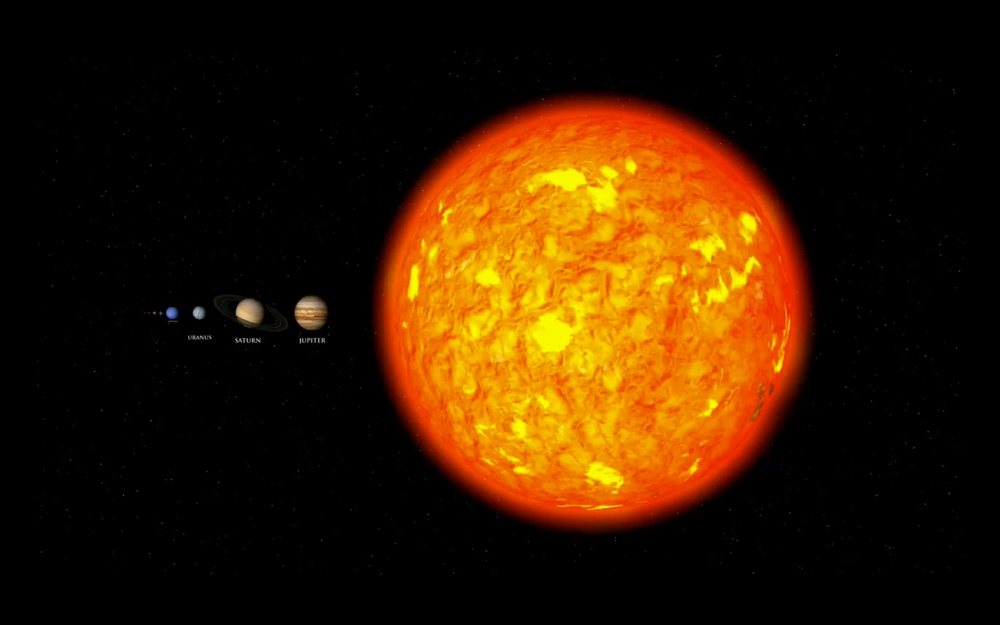
So how does it compare to the other stars we see out there? And actually today you may have heard in the news that the Gaia space mission, which has been mapping stars in our own galaxy, has released its first data. It's measured information about a billion stars in our own galaxy, that's a thousand billion stars, and that's a huge number, a ridiculous number. It's still only a small fraction of the total number of stars in our galaxy. But there are a lot out there, so how does our sun compare?
Well this animation drives us through our sun compared to some other stars. And I'm going upwards in size, as you can see, so we have Sirius, which is the brightest star in the sky. You can see that when the sun sets, [unclear], that's a red star, Aldebaran, so these are red giants, getting much much larger in size now. Rigel, that's in the constellation of Orion. Getting even bigger, Antares, and Betelgeuse. So when you start to look at other stars, our sun can potentially be dwarfed. But I don't want you to go away thinking that our sun is not special, it is still special. But it just sort of sits in the middle range.
The smallest stars we see in the universe may be about 10 per cent of the mass of our sun. The largest star, or the most massive star we've ever discovered, that was a discovery made by a team at Sheffield University, they found a star that's 260 times as massive as our sun, so massive that when it dies it will blow itself apart leaving nothing behind.
So our sun sort of sits in the middle of this spectrum. It's not particularly small, it's not particularly massive. I mentioned it has a magnetic field, but then all other stars have magnetic fields too.
So what does it do for us? They are sort of two things I want to say about our sun. And the first is that actually acts as a protector for us.
The sun's atmosphere doesn't end where the images seem to indicate. It simply thins as you go up in height. And it actually stretches out over all the planets, and it actually reaches out over 18 billion kilometres from the Earth. The edge of the sun has only just been discovered by the Voyager I spacecraft that was launched in 1977 and has been travelling out through the solar system ever since.
We sit in that atmosphere. We are living in the sun's atmosphere.
I've got a little artist's animation to show you of the galaxy, so you see the spiral arms and the bright centre. And then when I run it, we'll zoom in, and we'll zoom into one of the spiral arms where we are. And as we get closer and closer, you'll see the point of light that is our sun. And then what you'll start to see is this sort of wind sock that illustrates the extent of the sun's atmosphere. And we are hidden within that. The sun is moving through the galaxy, which is why it's drawn out like a windsock. It's compressed on one side and stretched out on the other, so the direction of motion is going up. We are embedded in that atmosphere. And it's important for us, because the sun's atmosphere acts as a shield, and it blocks very high energy particles that are called cosmic rays. They come from the centre of the galaxy, and if we were to encounter them, they could damage our skin, damage the cells in our body.
Simulated view of heliosphere from Little Atoms on Vimeo.
So this huge, inflated atmosphere of the sun acts as a shield to protect us from these very high energy particles. That was amazing for me when I found out. I never thought of our sun as a protector. I thought about it as a giver of life and a provider of energy, but not as a protector for us.
The second thought that I want to communicate is that the sun is a majestic object. And I very much see it this way. It's enormous. It's powerful. We rely on it. But it has these amazing forms of solar activity, and these are the kind of things that the rockoon was trying to capture.
I want to show you one animation now – this is an image of the sun in ultraviolet light.
Again, everything you see here is shaped by the presence of magnetic fields. The gas that you're seeing has a temperature of around 2 million degrees, 2 million Kelvin, incredibly hot. The centre of the sun is 15 million degrees, even hotter. But what I want to do is zoom in to one part of that image, and show you a video that's been heavily processed, in a way that will bring out changes in the sun's atmosphere. So where there's nothing changing you'll see grey, and where things are changing you'll see colour and brightness. And let's see what happens.
Changes in the sun's atmosphere from Little Atoms on Vimeo.
This is real data from the sun, sped up. You see this huge eruption that takes place, and this portion of the sun's atmosphere suddenly expands. Material flies up at thousands of kilometres a second. Some of the material is so heavy it falls down under gravity, and impacts back onto the surface of the sun. And these are the kinds of things we see on the sun all the time. It's incredibly beautiful, Perhaps I should say that before I trained as a scientist I wanted to be an artist, so I did a year of art, and these kind of images still tickle that side of me. The aesthetics of the sun are incredibly, and the science is also incredible too.
The sun is our protector, but actually these kind of events are the biggest explosions we see happening in the solar system. They themselves can cause some problems for us. We have a sort of love-hate perhaps relationship with the sun. It protects us on the one hand, but if these kind of explosions reach out to the earth we also need to be a little bit careful.
Simon: Very handy for me that you mentioned art and originally training as an artist, because in the book of Sunspots, as I was doing my research I became obsessed with how painters have treated the sun, and how painting is all about light falling on the canvas. Turner famously was obsessed with light. It's probably apocryphal but I like to think it's true, his final words on his deathbed were "the sun is god". And there's an imaginative strain of theology in the book as well. But this poem's about the sun talking about his/her/its favourite painters, and telling little fibs about them all. There were five or six/ I'm going to do some of them now. You'll spot the painters, it's not very cryptic.
At a push, I’d have to say
that Vincent was my fave,
despite his weakness for starry nights,
those mirrors of wheat,
the gnawing gristle of existential...
well, you know what I mean:
that soggy stuff in the middle of you people.
Remember my tussle with the wind
to get the traveller to remove his coat
and the wind smote and stupidly smote
and I wooed with waves of woozy heat?
Well, it was just the same with Vince.
Remove the vestiges, hack through sinew,
scimitar the ear: a cinch.
Then send the iron through the heart
inch by superheated inch
______________________
At a push, I’d have to say
that Miró was my fave.
His gaze never left
that inner sunset;
his watch never let me off
the hook; that look towards
the thing I’ve heard you talk
about, the thing that waits,
that red, red, red, red, thing,
that fate. I watched him paint
The Happiness of Loving My Brunette
and felt a twinge of regret.
I watched his tapestry trashed
among three thousand souls.
He made art worth destroying,
I guess.
_____________________
At a push, I’d have to say
that Seurat was my fave,
divining the prism
through Divisionism,
apportioning the visible
particle by particle;
a little dotty perhaps,
pointedly finishing
that damned hat.
I liked to spend Sunday
in the park with George,
making my entrance again
with my usual flare.
Dogs and monkeys and parasols.
“Let’s go and get drunk
on light again. It consoles.”
_____________________
How’s my coal getting on?
I set as much aside as I could for you.
Don’t use it all at once.
It should come in handy one day.
How’s my oil faring? It keeps best in the dark, underground.
Doesn’t do so well in the light.
Don’t let it spoil.
I assume you’re using solar, right?
The other stuff’s for back-up.
Just in case there’s a rainy day
for me, in space.
Talking of which
one day you will sail away
on a fair wind of photons.
Remember me this way.
Read James Trevelyan's poem about the event, One Final Spectacle
Simon Barraclough's Sunspots is available to buy from the Penned In The Margins website
Lucie Green's 15 Million Degrees: A Journey To The Centre Of The Sun, is available from Waterstones

